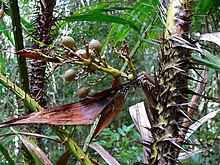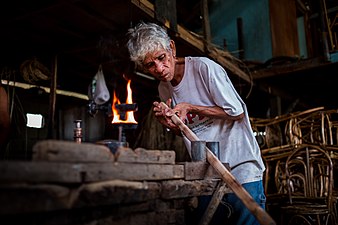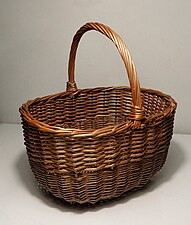| Species of Calamus |
Notes of utilization
|
| Calamus acanthospathus Griff. |
Canes for bridge cables, basketry
|
| Calamus andamanicus Kurz |
Excellent large-diameter canes harvested for furniture industry; leaves for thatching
|
| Calamus aruensis Becc. |
Excellent quality medium- to large-diameter canes for furniture
|
| Calamus arugda Becc. |
Entire canes for handicrafts, furniture, basketry, etc., local and export markets
|
| Calamus axillaris Becc. |
Small-diameter canes for basketry, fish traps and tying
|
| Calamus bacularis Becc. |
Canes for walking-sticks
|
| Calamus bicolor Becc. |
Ornamental use of young plants
|
| Calamus blumei Becc. |
Canes of good quality but quantities insufficient for commercial use; canes for baskets and mats
|
| Calamus boniensis Becc. ex Heyne |
Probably sold together with other small-diameter canes
|
| Calamus burckianus Becc. |
Canes for broom handles
|
| Calamus caesius Bl. |
Canes for commercial and traditional uses
|
| Calamus castaneus Becc. |
Leaves for thatch; immature fruits in traditional medicine
|
| Calamus ciliaris Bl. |
Slender canes for weaving and binding; seedlings used as ornamentals
|
| Calamus conirostris Becc. |
Canes of poor quality, rarely used; fruit eaten
|
| Calamus convallium J. Dransf. |
Canes
|
| Calamus cumingianus Becc. |
Entire canes made into handicrafts, furniture and baskets
|
| Calamus deërratus G. Mann & H. Wendl. |
Canes for construction and weaving
|
| Calamus densiflorus Becc. |
Canes for making furniture and baskets
|
| Calamus didymocarpus Warb. ex Becc. |
Canes inferior but used for local furniture-making
|
| Calamus diepenhorstii Miq. |
Canes for tying, cordage, basketry, fish traps and noose traps
|
| Calamus dimorphacanthus Becc. var. dimorphacanthus |
Canes used for baskets, bags, tying, etc. for home industries
|
| Calamus discolor Becc. |
Young plants as ornamentals; canes for binding or tying
|
| Calamus egregius Burr. |
Excellent small- to medium-diameter canes for binding and weaving in furniture; new shoots edible
|
| Calamus elmerianus Becc. |
Canes for furniture, handicrafts and home industries
|
| Calamus erioacanthus Becc. |
Canes of good quality
|
| Calamus exilis Griff. |
Canes for binding, weaving, basketry, handicrafts
|
| Calamus flabellatus Becc. |
Canes for tying, binding and weaving
|
| Calamus gamblei Becc. |
Canes for furniture
|
| Calamus gibbsianus Becc. |
Canes for tying and weaving
|
| Calamus gonospermus Becc. |
Edible fruit
|
| Calamus gracilis Roxb. |
Canes for handicrafts
|
| Calamus grandifolius Becc. |
Canes for furniture
|
| Calamus guruba (Buch-Ham) ex Mart. |
Canes for basketry, chair seats
|
| Calamus halconensis (Becc.) Baja-Lapis var. dimorphacanthus Becc. |
Canes for chair frames, cables for ferry boats, hauling logs and as rigging on small sailboats; split canes for mats, basketry, fish traps, chair seats
|
| Calamus heteroideus Bl. |
Canes for cordage
|
| Calamus hispidulus Becc. |
Canes for weaving
|
| Calamus hookerianus Becc. |
Canes for furniture, basketry
|
| Calamus huegelianus Mart. |
Canes for basketry, chair frames, etc.
|
| Calamus inermis T. Anders. |
Canes for police sticks, chair frames
|
| Calamus inops Becc. ex Heyne |
Actual use of small- to medium-diameter canes not known
|
| Calamus insignis Becc. |
Split canes for basketry, cordage; spiny leaf-sheaths as food graters
|
| Calamus javensis Bl. |
Canes for cordage, basketry, noose traps, musical instruments; edible raw cabbage as medicine; spiny leaf-sheaths formerly used to make food graters
|
| Calamus koordersianus Becc. |
Canes locally for basket frames
|
| Calamus laevigatus Mart. |
Extensively collected as small-diameter cane, end-uses not documented
|
| Calamus latifolius Roxb. |
Canes for basketry, walking-sticks, furniture frames; split canes for chair seats
|
| Calamus leiocaulis Becc. ex Heyne |
Small-diameter canes extensively used to make furniture for local and export markets
|
| Calamus leptospadix Griff. |
Canes for basketry and chair seats
|
| Calamus leptostachys Becc. ex Heyne |
Excellent small-diameter canes for furniture and handicrafts for local and export markets
|
| Calamus longisetus Griff. |
Coarse cane for furniture; leaves for thatch; edible fruit
|
| Calamus longispathus Ridl. |
Young leaves occasionally as cigarette paper; fruits as medicine
|
| Calamus luridus Becc. |
Canes split for tying and binding
|
| Calamus manan Miq. |
Most desirable large-diameter canes for furniture
|
| Calamus manillensis (Mart.) H. Wendl. |
Edible fruit; canes of inferior quality for tying
|
| Calamus marginatus (Bl.) Mart. |
Poor quality but durable canes for basket frames and walking-sticks
|
| Calamus mattanensis Becc. |
Canes occasionally used to make coarse baskets
|
| Calamus megaphyllus Becc. |
Canes for basketry and tying
|
| Calamus melanorhynchus Becc. |
Canes for basketry and handicrafts
|
| Calamus merrillii Becc. |
Entire canes for chair frames, ferry boat cables, hauling logs, sailboat rigging; split canes for basketry, chairs, fish traps, etc.
|
| Calamus microcarpus Becc. |
Canes for basketry
|
| Calamus microsphaerion Becc. |
Entire canes for basketry
|
| Calamus minahassae Becc. |
Canes as cordage
|
| Calamus mindorensis Becc. |
Popular large-diameter canes for furniture; split canes for basketry, cordage
|
| Calamus mitis Becc. |
Canes for basketry and tying
|
| Calamus moseleyanus Becc. |
Canes for furniture
|
| Calamus multinervis Becc. |
Canes for furniture
|
| Calamus muricatus Becc. |
Cabbage eaten
|
| Calamus myriacanthus Becc. |
Canes for walking-sticks, cages, basket frames
|
| Calamus nagbettai Fernandez & Dey |
Canes for basketry
|
| Calamus nambariensis Becc. |
Canes for handicrafts
|
| Calamus optimus Becc. |
Canes used to make mats, for weaving, to bind furniture and cordage
|
| Calamus ornatus Bl. |
Major use of canes for furniture; also for walking-sticks, handles for implements and flooring; leaves, cabbage and roots as medicine; fruits occasionally eaten
|
| Calamus ovoideus Thwaites ex Trimen |
Split canes for basketry; entire canes for furniture frames; split cane cores for crude woven products
|
| Calamus oxleyanus Teysm. & Binnend. ex Miq. |
Canes for walking-sticks
|
| Calamus palustris Griff. |
Canes excellent for furniture frames
|
| Calamus pandanosmus Furt. |
Canes
|
| Calamus paspalanthus Becc. |
Seedlings as potential ornamental; ripe fruit pickled and young shoot eaten
|
| Calamus pedicellatus Becc. ex Heyne |
Canes apparently of good quality for furniture
|
| Calamus perakensis Becc. |
Canes occasionally used for walking-sticks
|
| Calamus peregrinus Furt. |
Robust canes of good quality for furniture
|
| Calamus pilosellus Becc. |
Canes of good appearance but probably only for local use
|
| Calamus pogonacanthus Becc. ex H. Winkler |
Canes of good quality for tying, binding and making coarse mats
|
| Calamus poilanei Conrad |
Canes for handicrafts
|
| Calamus polystachys Becc. |
Coarse canes used for broom handles
|
| Calamus pseudorivalis Becc. |
Canes for furniture
|
| Calamus pseudotenuis Becc. |
Canes for basketry
|
| Calamus pseudoulur Becc. |
Canes for basketry, etc.
|
| Calamus ramulosus Becc. |
Canes for furniture
|
| Calamus reyesianus Becc. |
Canes of small diameter use for furniture and basketry, local and international
|
| Calamus rhomboideus Bl. |
Canes possibly used to make baskets and mats
|
| Calamus rhytidomus Becc. |
Canes used locally for binding
|
| Calamus rotang Linn. |
Canes for basketry, chair seats
|
| Calamus rudentum Lour. |
Canes for handicrafts; edible fruit
|
| Calamus ruvidus Becc. |
Canes used for basketry and tying
|
| Calamus scabridulus Becc. |
Canes split for tying, thatching and cordage
|
| Calamus scipionum Lour. |
Canes for making moderate-quality furniture; walking-sticks, umbrella handles, etc.
|
| Calamus sedens J. Dransf. |
Canes sometimes used to make walking-sticks
|
| Calamus semoi Becc. |
Excellent quality cane; under cultivation in gardens
|
| Calamus simplex Becc. |
Canes for basketry
|
| Calamus simplicifolius Wei |
Good medium-diameter cane for furniture, binding, weaving, basketry, etc.; new shoots edible
|
| Calamus siphonospathus Mart. |
Canes for basketry and tying
|
| Calamus solitarius T. Evans et al. |
Canes for handicrafts
|
| Calamus spinifolius Becc. |
Canes for basketry and tying
|
| Calamus subinermis H. Wendl. ex Becc. |
Canes for furniture frames; cabbage cooked as a vegetable; fruit sometimes eaten
|
| Calamus symphysipus Becc. |
Canes for furniture
|
| Calamus tenuis Roxb. |
Canes for basketry; fruits and young shoots eaten
|
| Calamus tetradactylus Hance |
Small-diameter canes for handicrafts, basketry and furniture
|
| Calamus thwaitesii Becc. |
Canes for furniture
|
| Calamus tomentosus Becc. |
Canes for tying and binding
|
| Calamus trachycoleus Becc. |
Canes used as skin peels for weaving chair seats and back; unsplit for furniture; basketry, mats, fish traps, cordage
|
| Calamus travancoricus Bedd. ex Becc. & Hook |
Canes for handicrafts and furniture
|
| Calamus trispermus Becc. |
Canes for furniture
|
| Calamus tumidus Furt. |
Canes for furniture
|
| Calamus ulur Becc. |
Split canes for cordage
|
| Calamus unifarius H. Wendl. |
Canes locally for furniture
|
| Calamus usitatus Becc. |
Canes for basketry, furniture and handicrafts
|
| Calamus vidalianus Becc. |
Canes for furniture
|
| Calamus viminalis Willd. |
Canes locally for basketry and matting
|
| Calamus wailong S.J. Pei & S.Y. Chen |
Canes for weaving and furniture
|
| Calamus warburgii K. Schum. |
Canes locally for basket frames
|
| Calamus ollingeri Becc. |
Canes for furniture frames
|














